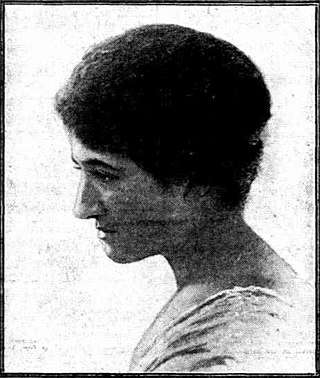
John Villiers Farrow, KGCHS was an Australian film director, producer, and screenwriter. Spending a considerable amount of his career in the United States, in 1942 he was nominated for the Academy Award for Best Director for Wake Island, and in 1957 he won the Academy Award for Best Adapted Screenplay for Around the World in Eighty Days. He had seven children by his wife, actress Maureen O'Sullivan, including actress Mia Farrow.

The Athenaeum or Melbourne Athenaeum at 188 Collins Street is an art and cultural hub in the central business district of Melbourne, Victoria, Australia. Founded in 1839, it is the city's oldest cultural institution.

Clarice Marjoribanks Beckett was an Australian artist and a key member of the Australian tonalist movement. Known for her subtle, misty landscapes of Melbourne and its suburbs, Beckett developed a personal style that contributed to the development of modernism in Australia. Disregarded by the art establishment during her lifetime, and largely forgotten in the decades after her death, she is now considered one of Australia's greatest artists.

Lotus Thompson was an Australian actress of silent and sound films. Her film career began in Australia in 1921 and ended in California in 1949, during which time she appeared in 35 motion pictures. She died in California in 1963.

Mary Carr, was an American film actress and was married to the actor William Carr. She appeared in more than 140 films from 1915 to 1956. She was given some of filmdoms plum mother roles in silent pictures, especially Fox's 1920 Over the Hill to the Poorhouse, which was a great success. She was interred in Calvary Cemetery. Carr bore a strong resemblance to Lucy Beaumont, another famous character actress of the time who specialized in mother roles. As older actresses such as Mary Maurice and Anna Townsend passed on, Carr, still in her forties, seem to inherit all the matriarchal roles in silent films.

Gertrude Olmstead was an American actress of the silent era. She appeared in 56 films between 1920 and 1929. Her last name was sometimes seen as Olmsted.

Percy Marmont was an English film actor.
Allan Wilkie CBE was an English Shakespearean actor of Scottish descent noted for his career in Australia.
The Breaking of the Drought is a 1920 Australian silent film from director Franklyn Barrett based on the popular play by Bland Holt and Arthur Shirley. According to Graham Phillips, this film is one of the most damaged films in Australia's film archive, although few sequences have severe damage in the film.

Jessica Harcourt (1905–1988) was an Australian mannequin, author and actress, best known for playing a leading role in For the Term of His Natural Life (1927).
The Sun-Herald Tournament was a golf tournament held in Australia from 1924 to 1926. It was the first Australian tournament with significant prize money and was run along the lines of the British News of the World Match Play. The first event in 1924 was sponsored by The Sun newspaper in Sydney and was called the Sun Tournament. In 1925 and 1926 the events were co-sponsored by The Herald newspaper in Melbourne. The 1925 event was held in Melbourne and was called the Herald-Sun tournament while 1926 the event returned to Sydney and was called the Sun-Herald Tournament. The 1926 event was combined with the Australian Professional Championship.

Arthur Maybee Chanter (1866-1950) was an Australian composer, conductor, music teacher, choir master and musician. An accomplished pianist and watercolorist, Chanter was among the earliest music graduates of the University of Melbourne, where he was instructed by George Marshall-Hall. In 1910 Chanter was the adjudicator of a musical Eistedfodd and band competition of an association of native-born Australians in Western Australia. He married Josephine in 1902 but divorced her in 1914, taking another wife Sara Kate Campbell in 1915. He live mostly in Brighton, Victoria and Elsternwick, but was well travelled. He advocated recording as a means to reach the working clubs and masses and was damning of the teaching methods in public schools. He retired to Euroa and died 28 November 1950, and is buried in Cheltenhan pioneer cemetery.
William Rufus Clyde Stewart was an Australian professional golfer. He won the 1927 Australian Open and the 1929 Australian Professional Championship. In 1928 he travelled to Britain and America, playing in the Open Championship and the U.S. Open. He also travelled to Europe in 1931, again playing in the Open Championship.
Frederick Popplewell was an Australian professional golfer. He won the Australian Open twice, in 1925 and 1928.
Leonard Nettlefold was an Australian businessman and amateur golfer. He won the Australian Amateur twice, in 1926 and 1928, and won the Tasmanian Open and the Tasmanian Amateur, eight times each.

Pegg Clarke was an Australian professional fashion, portrait, architectural and society photographer whose work, published frequently in magazines, was referred to by historian Jack Cato as being of "the highest standard."

Jean Robertson was an Australian stage and screen actress.

Dorothy Harriette Dunckley was an Australian make-up artist, actress and writer.

Clara Serena Kleinschmidt was an Australian operatic contralto singer, professionally known as Clara Serena. She had a successful career in London and in Europe, which was interrupted by the World War I, and resumed in 1923 with Roy Mellish, her accompanist and husband. They retired to South Australia in 1951.
Alice Mary Mallon (1900–1992) was an Australian soprano.













